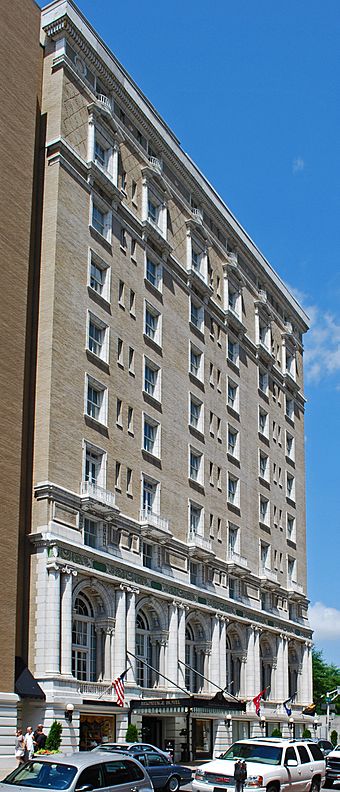Hermitage Hotel facts for kids
|
Hermitage Hotel
|
|
 |
|
| Location | 231 6th Ave. N, Nashville, Tennessee |
|---|---|
| Built | 1908 |
| Architect | Carpenter, J.Edwin |
| Architectural style | Beaux Arts |
| NRHP reference No. | 75001749, 100005652 |
Quick facts for kids Significant dates |
|
| Added to NRHP | July 24, 1975 |
| Designated NHL | August 28, 2020 |
The Hermitage Hotel is a very old and famous hotel. It is located at 231 6th Avenue North in Nashville, Tennessee. Many people from Nashville helped pay for it in 1908. The hotel opened in 1910. It was named after Andrew Jackson's home, The Hermitage, which is also near Nashville.
The hotel was built in the Beaux-Arts style. This is a grand and fancy style of building. The Hermitage Hotel is the only building of its kind left in Tennessee. It was made a National Historic Landmark in 2020. This was because it played a big part in women getting the right to vote. The hotel is also part of Historic Hotels of America. This group protects important old hotels.
Contents
History of the Hermitage Hotel
The Hermitage Hotel was built right in the middle of downtown Nashville. It was just two blocks from the state capitol building. This area became a busy business district in the early 1900s. The hotel opened its doors on September 17, 1910. It was one of Nashville's first tall buildings, called a "skyscraper" back then.
In 1910, the hotel told people its rooms were "fireproof, noise proof, and dust proof." Rooms started at $2.00. The hotel had all the newest things. Each room had a telephone and even ice water that flowed from the tap! They also had very high standards for helping their guests.
Inside the Hotel
The main lobby of the hotel was, and still is, very special. It is a large and beautiful Beaux-Arts room. It has lots of fancy plaster designs and a painted glass ceiling. When you walk in, a big staircase leads to the lobby. The walls are made of golden-colored marble.
The main dining room was once off the lobby. It is now called the Grand Ballroom. It had rich Circassian walnut walls and a fancy ceiling. These beautiful features are still there today. There was also a social room called the Loggia. It looked out over the street. Downstairs, near the Oak Bar, was the Grille Room. It was designed like an old German pub.
The hotel also had shops along the street. These included a pharmacy and a clothing store. Later, it became an American Airlines ticket office. The hotel also had an exhibit hall on the top floor. Salesmen used rooms on the eighth floor to show their products. There was a cigar and newsstand in the lobby. A barbershop was on the Grille level.
A Place for Important Events
The Hermitage Hotel was a very important place in 1920. It became a national meeting spot for people who wanted women to vote and those who did not. Tennessee was the 36th state to agree to the 19th Amendment. This amendment gave women the right to vote. This final step happened in Tennessee, and the hotel was at the center of it all.
The hotel also has strong ties to Nashville's music history. Its own "big band," the Francis Craig Orchestra, was very popular. Mr. Craig and his musicians were part of the first live radio show for station WSM in 1925. This station later started the famous Grand Ole Opry. In 1947, Francis Craig's song, "Near You," became America's best-selling record. This success helped big record companies come to Nashville. It helped make Nashville known as "Music City."
Famous Visitors
Many important people have stayed at the Hermitage Hotel. Presidents like William Howard Taft, Woodrow Wilson, John F. Kennedy, Lyndon B. Johnson, and Richard Nixon have visited. State politicians often used the hotel for campaigns and meetings. Famous people like Charlie Chaplin and boxer Jack Dempsey also enjoyed staying there. The hotel was known for its great service and food.
Saving the Hotel
By the end of 1977, the hotel closed. People were not visiting the city center as much, and the hotel was struggling. Local groups and Mayor Richard Fulton worked hard to save the Hermitage. They also saved other famous Nashville places like Ryman Auditorium.
The hotel got new owners and was completely fixed up. It reopened in 1981. It changed owners a few more times in the 1980s and 1990s. A famous pool player, Rudolf Wanderone, lived there for a while. In 2000, a new company bought the hotel. They completely updated the guest rooms and public areas.
The Hermitage Hotel used to have 250 rooms. Now it has 122 rooms, all with five-fixture bathrooms. It reopened on Valentine's Day in 2003. In 2007, it received the American Automobile Association (AAA) Five-Diamond rating. This is a very high honor for hotels. It is still the only AAA Five-Diamond hotel in Tennessee. It also received a Forbes 5-Star rating in 2008, which it still holds.
Music Connections
The Francis Craig Orchestra played in the Oak Bar and Grille Room from 1929 to 1945. Craig's orchestra was also the first to be heard on WSM radio. They had a very popular show for 12 years that was broadcast across the entire NBC network. In 1949, Francis Craig introduced a new singer named Dinah Shore. She sang a new song called "Near You" to his audience.
See also
 In Spanish: Hermitage Hotel para niños
In Spanish: Hermitage Hotel para niños



